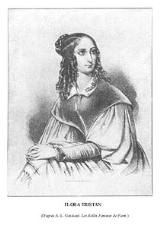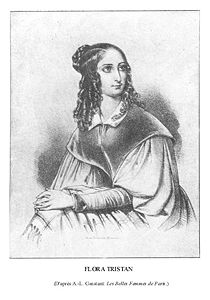
Flora Tristan
Encyclopedia


Paris
Paris is the capital and largest city in France, situated on the river Seine, in northern France, at the heart of the Île-de-France region...
– 14 November 1844 in Bordeaux
Bordeaux
Bordeaux is a port city on the Garonne River in the Gironde department in southwestern France.The Bordeaux-Arcachon-Libourne metropolitan area, has a population of 1,010,000 and constitutes the sixth-largest urban area in France. It is the capital of the Aquitaine region, as well as the prefecture...
, France
France
The French Republic , The French Republic , The French Republic , (commonly known as France , is a unitary semi-presidential republic in Western Europe with several overseas territories and islands located on other continents and in the Indian, Pacific, and Atlantic oceans. Metropolitan France...
) was a socialist writer and activist. She was also one of the founders of modern feminism
Feminism
Feminism is a collection of movements aimed at defining, establishing, and defending equal political, economic, and social rights and equal opportunities for women. Its concepts overlap with those of women's rights...
. She wrote several works, the best known of which are Peregrinations of a Pariah (1838), Promenades in London (1840), and The Workers' Union (1843).
She was Paul Gauguin
Paul Gauguin
Eugène Henri Paul Gauguin was a leading French Post-Impressionist artist. He was an important figure in the Symbolist movement as a painter, sculptor, print-maker, ceramist, and writer...
's grandmother through Alina María Chazal.
Early life
Her complete name was Flore-Celestine -Therèse-Henriette Tristan-Moscoso. Her father, Mariano Tristán y Moscoso, was an Arequipa-bornArequipa
Arequipa is the capital city of the Arequipa Region in southern Peru. With a population of 836,859 it is the second most populous city of the country...
Peru
Peru
Peru , officially the Republic of Peru , is a country in western South America. It is bordered on the north by Ecuador and Colombia, on the east by Brazil, on the southeast by Bolivia, on the south by Chile, and on the west by the Pacific Ocean....
vian colonel of the Spanish Navy
Spanish Navy
The Spanish Navy is the maritime branch of the Spanish Armed Forces, one of the oldest active naval forces in the world. The Armada is responsible for notable achievements in world history such as the discovery of Americas, the first world circumnavigation, and the discovery of a maritime path...
. She was the niece of Pío de Tristán
Pío de Tristán
Juan Pío de Tristán was a Peruvian general and politician...
, viceroy of Peru. Her mother, Anne Laisney, was French
French people
The French are a nation that share a common French culture and speak the French language as a mother tongue. Historically, the French population are descended from peoples of Celtic, Latin and Germanic origin, and are today a mixture of several ethnic groups...
; her parents met in Bilbao, Spain during her father's stay there.
When her father died before her fifth birthday in 1807, the situation of Tristan and her mother changed drastically from the high standards of living they were accustomed to. They travelled to Arequipa in 1832 to claim her paternal inheritance, which was in possession of this uncle. She remained in the country until 16 July 1834. Though she never secured the inheritance that brought her to Peru, Tristan wrote a travel diary about her experiences during its tumultuous post-independence period
History of Peru
The history of Peru spans several millennia, extending back through several stages of cultural development in the mountain region and the coastal desert....
. The diary was published in 1838 as Pérégrinations d'une paria.
Mario Vargas Llosa
Mario Vargas Llosa
Jorge Mario Pedro Vargas Llosa, 1st Marquis of Vargas Llosa is a Peruvian-Spanish writer, politician, journalist, essayist, and Nobel Prize laureate. Vargas Llosa is one of Latin America's most significant novelists and essayists, and one of the leading authors of his generation...
, in his historical novel The Way to Paradise
The Way to Paradise
The Way to Paradise is a novel published by Mario Vargas Llosa in 2003.The novel is a historical double biography of Post-Impressionist painter Paul Gauguin and his grandmother Flora Tristan, one of the founders of feminism. The book is divided into 11 chapters, each alternating narratives of...
, analyzes Flora Tristan and her grandson Paul Gauguin
Paul Gauguin
Eugène Henri Paul Gauguin was a leading French Post-Impressionist artist. He was an important figure in the Symbolist movement as a painter, sculptor, print-maker, ceramist, and writer...
's contrasting quests for the ideal life through their experiences outside their native France.
The Workers' Union
Tristan wrote this essay in 1843 after an extensive rest in Peru and a short trip to Britain, where she produced works on the social conditions along the Channel. The Workers' Union was the last of her writings and gave her a public persona of political activist. Through this work, one can compare Tristan to similar Utopian SocialistsUtopian socialism
Utopian socialism is a term used to define the first currents of modern socialist thought as exemplified by the work of Saint-Simon, Charles Fourier, and Robert Owen which inspired Karl Marx and other early socialists and were looked on favorably...
including Charles Fourier
Charles Fourier
François Marie Charles Fourier was a French philosopher. An influential thinker, some of Fourier's social and moral views, held to be radical in his lifetime, have become main currents in modern society...
(whom she knew personally) and the works of the French Socialists, the Saint Simonians
Saint-Simonianism
Saint-Simonianism was a French political and social movement of the first half of the 19th century, inspired by the ideas of Claude Henri de Rouvroy, comte de Saint-Simon ....
, whose works she had studied throughout the years. Tristan takes into account the studies and teachings of these previous socialists, but creates a different and arguably more effective solution to the suppression of not only the proletariats, but the working women as well. She is the first to acknowledge the undeniable connection between the freedom of the working class and the deliverance of women’s rights.
Tristan recognizes that the working class had been fighting for over twenty-five years to no avail. Her suggested solution is to act and create a Workers' Union. She sees a great advantage to this because “divided, you are weak and fall, crushed underfoot by all sorts of misery! Union makes power. You have numbers in your favor, and numbers mean a great deal.” Through union dues, she insists on plans to provide the proletariats’ children with safe havens and increased access to education, to build palaces for the ill and wounded workers, and reach out to manufacturers and financiers, including those among the nobility, in order to sustain and maintain such programs.
Although seemingly two different essays, Flora Tristan acknowledges the need for the liberation of women in order to complete the emancipation of the working class. The society is not whole and the working class itself is fractured. She argues that once society fixes the pieces of the fissure (women’s rights) then the rest will fall into place. In a sense, women’s liberation will lead to the greatest good for the greatest amount of people thereby supporting a Utilitarian mindset. Although thinking positively about women’s liberation, Tristan did recognize that in the post-revolution French society, women would not be easily considered equal just because they are human beings. Therefore, Tristan had to make the argument based on a series of benefits to the male majority. By feeding into the male ego, she opens up a new line of communication that no socialist had been able to tap into before.
This effort at creating a common union was the last before Flora Tristan’s death in 1844. By drawing and building upon her colleagues’ and mentors’ socialist concepts, she created a logical and reasonable plan that the proletariats could realistically achieve. She opted to change the angle previously attempted and was able to include women’s rights as an important lever in the machine to create an independent Workers' Union.
Landmarks
Place Flora Tristan (48.832394°N 2.320632°E) in the XIVe ArrondissementXIVe arrondissement
The 14th arrondissement of Paris is one of the 20 arrondissements of the capital city of France....
, Paris
Paris
Paris is the capital and largest city in France, situated on the river Seine, in northern France, at the heart of the Île-de-France region...
, is marked with a sign describing Tristan as "Femme de Lettres" and "Militante Féministe".

